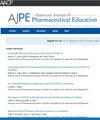Tools for Assessing Communication in Pharmacy Education: Review and Recommendations
IF 3.8
4区 教育学
Q1 EDUCATION, SCIENTIFIC DISCIPLINES
引用次数: 0
Abstract
Objectives
Well-developed and finely tuned communication skills are foundational for pharmacists and should be at the core of Doctor of Pharmacy curricula. This narrative review aimed to identify and summarize useful instruments for pharmacy educators interested in assessing communication skills.
Findings
Fifty-seven studies were evaluated. Eighteen studies with communication assessment instruments that were readily available and deemed useful by the research team were included for further review. Most focused on oral communication (n = 15), included pharmacy students as the communicators (n = 14), and utilized instructors as the assessors in the didactic, simulation, objective structured clinical examination, or experiential settings (n = 18). The communication tasks (eg, patient counseling; medication history taking; subjective, objective, assessment, plan notes), contexts (eg, community pharmacy), and scales of measurement varied for each instrument.
Summary
Although communication is a critical skill for pharmacy students, its assessment is complicated by the potential need for various types of assessors, communication tasks, and contexts. This review describes a set of useful assessment instruments to aid pharmacy educators in selecting an appropriate tool or adapting an existing one to meet their course or program assessment needs.
评估药学教育中交流的工具:回顾与建议》。
目标:完善和精巧的沟通技能是药剂师的基础,应成为药学博士课程的核心。本综述旨在为有兴趣评估沟通技能的药学教育者确定和总结有用的工具:对 57 项研究进行了评估。其中 18 项研究的沟通评估工具是现成的,而且研究小组认为这些工具非常有用,因此将其纳入了进一步的综述。大多数研究侧重于口语交流(15 项),将药学专业学生作为交流者(14 项),并在授课、模拟、OSCE 或体验环境中利用指导者作为评估者(18 项)。每种工具的沟通任务(如患者咨询、用药史采集、SOAP 笔记)、情境(如社区药房)和测量尺度都各不相同。摘要:虽然沟通是药学专业学生的一项重要技能,但由于可能需要各种类型的评估者、沟通任务和情境,其评估也变得复杂起来。本综述介绍了一系列有用的评估工具,以帮助药学教育者选择合适的工具或调整现有工具,满足其课程或项目评估的需要。
本文章由计算机程序翻译,如有差异,请以英文原文为准。
求助全文
约1分钟内获得全文
求助全文
来源期刊
CiteScore
4.30
自引率
15.20%
发文量
114
期刊介绍:
The Journal accepts unsolicited manuscripts that have not been published and are not under consideration for publication elsewhere. The Journal only considers material related to pharmaceutical education for publication. Authors must prepare manuscripts to conform to the Journal style (Author Instructions). All manuscripts are subject to peer review and approval by the editor prior to acceptance for publication. Reviewers are assigned by the editor with the advice of the editorial board as needed. Manuscripts are submitted and processed online (Submit a Manuscript) using Editorial Manager, an online manuscript tracking system that facilitates communication between the editorial office, editor, associate editors, reviewers, and authors.
After a manuscript is accepted, it is scheduled for publication in an upcoming issue of the Journal. All manuscripts are formatted and copyedited, and returned to the author for review and approval of the changes. Approximately 2 weeks prior to publication, the author receives an electronic proof of the article for final review and approval. Authors are not assessed page charges for publication.

 求助内容:
求助内容: 应助结果提醒方式:
应助结果提醒方式:


